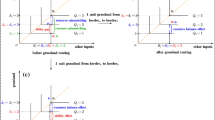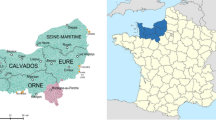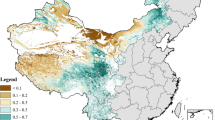Abstract
Grassland property rights privatization has alleviated the problem of ‘the tragedy of the commons’ but led to an unintended ecological consequence—traditional nomadic modes declination. However, with the grassland rental market formation in countries with property rights privatization, grassland rental has reshaped the pattern of grassland allocation and provided opportunities for herders to optimize their grazing modes. Based on the survey data of herders in northern China, we theoretically analyze and empirically test grassland rental’s impact on herders’ rotational grazing behavior under the household responsibility system. The results show that grassland rental promotes herders’ rotational grazing, and the probability of individual rotational grazing is increased by 58.27%. By increasing the operated grazing grassland area and the number of grassland plots fenced, grassland rental promotes herders’ grassland endowment match with the large-scale livestock activity space and the number of grazing blocks required for rotational grazing, reduces the input cost and operation difficulty required for rotational grazing, and increase herders rotational grazing probability. Grassland rental’s impact on herder’s rotational grazing is heterogeneous, showing the dependence of the number of plots fenced and the scale of grazing grassland. It has a higher promotion effect on herders with more plots fenced; It cannot promote the generation of herders’ rotational grazing behavior when the rented grassland area fails to make the grassland operation scale reach the minimum threshold of rotational grazing. The study emphasizes the importance of developing a grassland rental market to promote the optimization of grazing modes in grassland privatization countries.


Similar content being viewed by others
Notes
Before grassland HRS, livestock and grassland were managed by communes, which employed herders (villagers in the community) and paid them wages.
The grassland rental rate equals the ratio of the rented grassland area to the operated grassland area.
The marginal effect at the sample means: 0.1346 + (−0.0047*3.011) = 0.1204.
18.3185*0.0018 = 0.0330.
1.3451*0.1204 = 0.1620.
The median and mean of plots fenced operated by sample herders are 3 and 3.01, respectively.
There are great differences in the quantity and quality of grazing grassland in different regions. Therefore, the median area of grazing grassland operated by sample herders in each county is used as the basis for the division. The median area of grazing grassland operated by herders in Tianzhu Tibetan Autonomous County, Sonid Left Banner, West Ujimqin Banner, Otog Banner, XilinHot, and Bordered Yellow Banner are 546.25 mu, 8200 mu, 2420 mu, 3000 mu, 5080 mu, and 1928 mu respectively.
References
Banks T (2003) Property rights reform in rangeland china: dilemmas on the road to the household ranch. World Dev 31:2129–2142. https://doi.org/10.1016/j.worlddev.2003.06.010
Baronti S, Ungaro F, Maienza A, Ugolini F, Lagomarsino A, Agnelli AE, Calzolari C, Pisseri F, Robbiati G, Vaccari FP (2022) Rotational pasture management to increase the sustainability of mountain livestock farms in the Alpine region. Regional Environ Change 22:50. https://doi.org/10.1007/s10113-022-01896-1
Boone RB, Hobbs NT (2004) Lines around fragments: effects of fencing on large herbivores. Afr J Range Forage Sci 21:147–158. https://doi.org/10.2989/10220110409485847
Briske DD, Derner JD, Brown JR, Fuhlendorf SD, Teague WR, Havstad KM, Gillen RL, Ash AJ, Willms WD (2008) Rotational grazing on rangelands: reconciliation of perception and experimental evidence. Rangel Ecol Manag 61:3–17. https://doi.org/10.2111/06-159r.1
Coase RH (1960) The problem of social cost. J Law Econ 3:1–44
Cristina Vecchio M, Bolanos VA, Golluscio RA, Rodriguez AM (2019) Rotational grazing and exclosure improves grassland condition of the halophytic steppe in Flooding Pampa (Argentina) compared with continuous grazing. Rangel J 41:1–12. https://doi.org/10.1071/rj18016
Deininger K, Jin SQ (2005) The potential of land rental markets in the process of economic development: evidence from China. J Dev Econ 78:241–270. https://doi.org/10.1016/j.jdeveco.2004.08.002
Ellis JE, Swift DM (1988) Stability of African pastoral ecosystems: alternate paradigms and implications for development. J Range Manag 41:450–459. https://doi.org/10.2307/3899515
Feng X, Tang J, Qiu H (2022) The effect of grassland transfer on herders’ livestock production and grazing intensity in Inner Mongolia and Gansu, China. China Agric Econ Rev 14:242–258. https://doi.org/10.1108/caer-09-2020-0221
Fernandez-Gimenez ME (2000) The role of mongolian nomadic pastoralists’ ecological knowledge in rangeland management. Ecol Appl 10:1318–1326. https://doi.org/10.1890/1051-0761(2000)010[1318:TROMNP]2.0.CO;2
Fernandez-Gimenez ME, Allen-Diaz B (1999) Testing a non-equilibrium model of rangeland vegetation dynamics in Mongolia. J Appl Ecol 36:871–885. https://doi.org/10.1046/j.1365-2664.1999.00447.x
Galaty JG (2016) Reasserting the commons: pastoral contestations of private and state lands in East Africa. Int J Commons 10:709–727. https://doi.org/10.18352/ijc.720
Gongbuzeren, Huntsinger, L, Li, WJ, (2018) Rebuilding pastoral social-ecological resilience on the Qinghai-Tibetan Plateau in response to changes in policy, economics, and climate. Ecol Soc 23. https://doi.org/10.5751/es-10096-230221
Gongbuzeren, Li Y, Li W (2015) China’s rangeland management policy debates: what have we learned? Rangel Ecol Manag 68:305–314. https://doi.org/10.1016/j.rama.2015.05.007
Gongbuzeren, Zhuang M, Li W (2016) Market-based grazing land transfers and customary institutions in the management of rangelands: two case studies on the Qinghai-Tibetan Plateau. Land Use Policy 57:287–295. https://doi.org/10.1016/j.landusepol.2016.05.035
Hardin G (1968) The tragedy of the commons. Science 162:1243–1248. https://doi.org/10.1126/science.162.3859.1243
Herrero M, Havlik P, Valin H, Notenbaert A, Rufino MC, Thornton PK, Blummel M, Weiss F, Grace D, Obersteiner M (2013) Biomass use, production, feed efficiencies, and greenhouse gas emissions from global livestock systems. Proc Natl Acad Sci USA 110:20888–20893. https://doi.org/10.1073/pnas.1308149110
Hobbs NT, Galvin KA, Stokes CJ, Lackett JM, Ash AJ, Boone RB, Reid RS, Thornton PK (2008) Fragmentation of rangelands: Implications for humans, animals, and landscapes. Glob Environ Change-Hum Policy Dimens 18:776–785. https://doi.org/10.1016/j.gloenvcha.2008.07.011
Hou L, Xia F, Chen Q, Huang J, He Y, Rose N, Rozelle S (2021) Grassland ecological compensation policy in China improves grassland quality and increases herders’ income. Nat Commun 12:4683. https://doi.org/10.1038/s41467-021-24942-8
Hu Z, Kong D, Jiao J, Jin L (2014) Ecological environmental efficiency of grassland transfer: empirical study based on Inner Mongolia and Gansu. Issues Agric Econ 35:90–97. https://doi.org/10.13246/j.cnki.iae.2014.06.013
Hua LM, Squires VR (2015) Managing China’s pastoral lands: current problems and future prospects. Land Use Policy 43:129–137. https://doi.org/10.1016/j.landusepol.2014.11.004
Huang W, Bruemmer B, Huntsinger L (2017) Technical efficiency and the impact of grassland use right leasing on livestock grazing on the Qinghai-Tibetan Plateau. Land Use Policy 64:342–352. https://doi.org/10.1016/j.landusepol.2017.03.009
Hyland JJ, Heanue K, McKillop J, Micha E (2018) Factors influencing dairy farmers’ adoption of best management grazing practices. Land Use Policy 78:562–571. https://doi.org/10.1016/j.landusepol.2018.07.006
Lawrence R, Whalley RDB, Reid N, Rader R (2019) Short-duration rotational grazing leads to improvements in landscape functionality and increased perennial herbaceous plant cover. Agric Ecosyst Environ 281:134–144. https://doi.org/10.1016/j.agee.2019.04.031
Lesorogol CK (2008) Land privatization and pastoralist well-being in Kenya. Dev Change 39:309–331. https://doi.org/10.1111/j.1467-7660.2007.00481.x
Li, D, Hou, L, Zuo, A, 2021. Informal institutions and grassland protection: empirical evidence from pastoral regions in China. Ecol Econ 188. https://doi.org/10.1016/j.ecolecon.2021.107110.
Li W, Huntsinger L (2011) China’s grassland contract policy and its impacts on herder ability to benefit in inner mongolia: tragic feedbacks Ecol Soc 16:1
Li Y, Dong SK, Gao QZ, Zhang Y, Liu SL, Ganjurjav H, Hu GZ, Wang XX, Yan YL, Wu HB, Gao XX, Li S, Zhang J (2020) Rotational grazing promotes grassland aboveground plant biomass and its temporal stability under changing weather conditions on the Qinghai-Tibetan plateau. Land Degrad Dev 31:2662–2671. https://doi.org/10.1002/ldr.3596
Li Y, Li W (2012) Why “Balance of Forage and Livestock” system failed to reach sustainable grassland utilization. J China Agric Univ 29:124–131. https://doi.org/10.3969/j.issn.1009-508X.2012.01.013
Liu M, Dries L, Heijman W, Zhu X, Deng X, Huang J (2019) Land tenure reform and grassland degradation in Inner Mongolia, China. China Econ Rev 55:181–198. https://doi.org/10.1016/j.chieco.2019.04.006
Liu, M, Huang, J, Dries, L, Heijman, W, Zhu, X, 2020. How does land tenure reform impact upon pastoral livestock production? An empirical study for Inner Mongolia, China. China Econ Rev 60. https://doi.org/10.1016/j.chieco.2017.09.009
Manski CF (2000) Economic analysis of social interactions. J Econ Perspect 14:115–136. https://doi.org/10.1257/jep.14.3.115
Oba G, Stenseth NC, Lusigi WJ (2000) New perspectives on substainable grazing management in arid zones of sub-Saharan Africa. Bioscience 50:35–51
Ostrom E (1990) Governing the commons: the evolution of institutions for collective action. Cambridge University Press, New York
Pulido M, Schnabel S, Lavado Contador JF, Lozano-Parra J, Gonzalez F (2018) The impact of heavy grazing on soil quality and pasture production in rangelands of SW Spain. Land Degrad Dev 29:219–230. https://doi.org/10.1002/ldr.2501
Qi YJ, Li WJ (2021) A nested property right system of the commons: perspective of resource system-units. Environ Sci Policy 115:1–7. https://doi.org/10.1016/j.envsci.2020.10.009
Ravetto Enri S, Probo M, Farruggia A, Lanore L, Blanchetete A, Dumont B (2017) A biodiversity-friendly rotational grazing system enhancing flower-visiting insect assemblages while maintaining animal and grassland productivity. Agric Ecosyst Environ 241:1–10. https://doi.org/10.1016/j.agee.2017.02.030
Ren J (2012) Grazing, the basic form of grassland ecosystem and its transformation. J Nat Resour 27:1259–1275
Shi YX, Li CQ, Zhao MJ (2021) Herders’ aversion to wildlife population increases in grassland ecosystem conservation:Evidence from a choice experiment study. Glob Ecol Conserv 30:e01777. https://doi.org/10.1016/j.gecco.2021.e01777
Shi Y, Cai Y, Zhao M (2021) Social interaction effect of rotational grazing and its policy implications for sustainable use of grassland: evidence from pastoral areas in Inner Mongolia and Gansu, China. Land Use Policy 111:105734. https://doi.org/10.1016/j.landusepol.2021.105734
Shi Y, Zhao M (2022) Research on the influence of social capital and information channel on herders’ grassland renting-in behavior under the transformation of grassland renting market. J Northwest AF Univ (Soc Sci Ed) 22:115–128. https://doi.org/10.13968/j.cnki.1009-9107.2022.01.13
Shi, YX, Li, CQ, Zhao, MJ, (2022) The effect, mechanism, and heterogeneity of grassland rental on herders’ livestock production technical efficiency: evidence from pastoral areas in Northern China. Environ Dev Sustain https://doi.org/10.1007/s10668-022-02639-2
Shi, YX, Li, CQ, Zhao, MJ, (2023a) Behavioral mechanism of herders to maintain forage-livestock balance: an explanatory framework and empirical test incorporating emotions and desires. Curr Psychol https://doi.org/10.1007/s12144-023-04709-8
Shi, YX, Li, CQ, Zhao, MJ, Du, RR, (2023b) Can grassland rental achieve a win-win situation between livestock production and grassland ecological conservation? Evidence from pastoral areas in Northern China. J Environ Plan Manag https://doi.org/10.1080/09640568.2022.2078691
Su L, Tang J, Qiu H (2021) Intended and unintended environmental consequences of grassland rental in pastoral China. J Environ Manag 285:112126. https://doi.org/10.1016/j.jenvman.2021.112126
Sullivan S, Rohde R (2002) On non-equilibrium in arid and semi-arid grazing systems. J Biogeogr 29:1595–1618. https://doi.org/10.1046/j.1365-2699.2002.00799.x
Tan S-H, Liu B, Zhang Q-Y, Zhu Y, Yang J-H, Fang X-J (2017) Understanding grassland rental markets and their determinants in eastern inner Mongolia, PR China. Land Use Policy 67:733–741. https://doi.org/10.1016/j.landusepol.2017.07.006
Tan S-H, Zhang R-X, Tan Z-C (2018a) Grassland rental markets and herder technical efficiency: ability effect or resource equilibration effect? Land Use Policy 77:135–142. https://doi.org/10.1016/j.landusepol.2018.05.030
Tan S, Li T, Liu B, Huntsinger L (2018b) How can sedentarised pastoralists be more technically efficient? A case from eastern Inner Mongolia. Rangel J 40:241–249. https://doi.org/10.1071/rj17128
Tan S, Tan Z (2017) Grassland tenure, livelihood assets and pastoralists’ resilience: evidence and empirical analyses from western China. Econ Polit Stud 5:381–403. https://doi.org/10.1080/20954816.2017.1384605
Teague R, Provenza F, Kreuter U, Steffens T, Barnes M (2013) Multi-paddock grazing on rangelands: why the perceptual dichotomy between research results and rancher experience? J Environ Manag 128:699–717. https://doi.org/10.1016/j.jenvman.2013.05.064
Undargaa S, McCarthy JF (2016) Beyond property: co-management and pastoral resource access in Mongolia. World Dev 77:367–379. https://doi.org/10.1016/j.worlddev.2015.08.012
Wang, T, Jin, HL, Kreuter, U, Feng, HL, Hennessy, DA, Teague, R, Che, YY, (2020) Challenges for rotational grazing practice: views from non-adopters across the Great Plains, USA. J Environ Manag 256. https://doi.org/10.1016/j.jenvman.2019.109941
Wang X (2009) From “Rangeland Leasing” to “Recentralization in Rangeland Conservation” ——Policies of Rangeland Conservation in North China. China Rural Surv 87:36–46,95
Wang X, Zhang Q, Xun L (2014) Climate change and social adaptability: Study on pastoral area of Inner Mongolia. Social Sciences Academic Press(China), Beijing
Zhang C, Li W, Fan M (2013) Adaptation of herders to droughts and privatization of rangeland-use rights in the arid Alxa Left Banner of Inner Mongolia. J Environ Manag 126:182–190. https://doi.org/10.1016/j.jenvman.2013.04.053
Zhang J, Cui X, Wang Y, Gongbuzeren, Zhuang M, Ji B (2020a) Ecological consequence of nomad settlement policy in the pasture area of Qinghai-Tibetan Plateau: from plant and soil perspectives. J Environ Manag 260:110114. https://doi.org/10.1016/j.jenvman.2020.110114
Zhang MA, Borjigin E, Zhang H (2007) Mongolian nomadic culture and ecological culture: on the ecological reconstruction in the agro-pastoral mosaic zone in Northern China. Ecol Econ 62:19–26. https://doi.org/10.1016/j.ecolecon.2006.11.005
Zhang R, Tan S, Hannaway D, Dai W (2020b) Multi-household grassland management pattern promotes ecological efficiency of livestock production. Ecol Econ 171:106618. https://doi.org/10.1016/j.ecolecon.2020.106618
Zhou DW, Zhong RZ, Sun HX, Huang YX, Fang Y (2015) Principles for design of rotational grazing systems. Acta Prataculturae Sin 24:176–184. https://doi.org/10.11686/cyxb20150220
Zhuang M, Gongbuzeren, Zhang J, Li W (2019) Community-based seasonal movement grazing maintains lower greenhouse gas emission intensity on Qinghai-Tibet Plateau of China. Land Use Policy 85:155–160. https://doi.org/10.1016/j.landusepol.2019.03.032
Funding
This work was supported by the National Natural Science Foundation of China (NO. 72303005, 72173097); Major Project of the National Social Science Foundation of China (No. 22&ZD083); China Postdoctoral Science Foundation (No. 2023M730071); the Chinese Academy of Engineering (NO. 2022-HZ-09).
Author information
Authors and Affiliations
Contributions
YS: Methodology, Data curation, Formal analysis, Writing - original draft, review & editing, Funding acquisition. CL: Investigation, Methodology, Software, Data curation, Visualization. MZ: Conceptualization, Supervision, Funding acquisition.
Corresponding author
Ethics declarations
Conflict of interest
The authors declare no competing interests.
Supplementary information
Rights and permissions
Springer Nature or its licensor (e.g. a society or other partner) holds exclusive rights to this article under a publishing agreement with the author(s) or other rightsholder(s); author self-archiving of the accepted manuscript version of this article is solely governed by the terms of such publishing agreement and applicable law.
About this article
Cite this article
Shi, Y., Li, C. & Zhao, M. Can Grassland Rental Lead to Herders’ Rotational Grazing Under the Grassland Household Responsibility System? Evidence from Pastoral Areas in Northern China. Environmental Management 73, 546–562 (2024). https://doi.org/10.1007/s00267-023-01903-z
Received:
Accepted:
Published:
Issue Date:
DOI: https://doi.org/10.1007/s00267-023-01903-z




